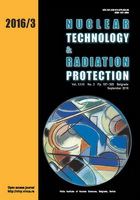
MEASURMENT OF RADON, THORON AND THEIR PROGENY IN INDOOR ENVIRONMENT OF MOHALI, PUNJAB, NORTHERN INDIA, USING PINHOLE DOSIMETERS

Vol.
XXXI, No. 3, Pp. 197-305
September 2016
UDC 621.039+614.876:504.06
ISSN 1451-3994
Pages: 299-305
Authors: Vimal Mehta, Deep Shikha, Suprret Pal Singh, Rishi Pal Chauhan, and Gurmel Singh MudaharAbstract
The health hazards of radon and its decay products above certain levels are well known. However, for any preventive measures to be taken, we have to be aware of radon levels of that particular area. Measurement of radon and its decay products in indoor environments is an important aspect of assessing indoor air quality and health conditions associated with it. Keeping this in mind, measurements of radon, thoron and their progeny concentrations were carried out in Mohali, Northern India, using pinhole-based twin cup dosimeters. Radon exhalation rates of soil samples in the dwellings/areas were measured via an active technique of a continuous radon monitor. The indoor radon concentration in Mohali varied from 15.03 ± 0.61 Bq/m3 to 39.21 ± 1.46 Bq/m3 with an average of 26.95 Bq/m3 ,while thoron concentration in the same dwellings varied from 9.62 ± 0.54 Bq/m3 to 52.84 ± 2.77 Bq/m3 with an average of 31.09 Bq/m3. Radon progeny levels in dwellings under study varied from 1.63 to 4.24 mWL, with an average of 2.94 mWL, while thoron progeny levels varied from 0.26 to 1.43 mWL , with an average of 0.84 mWL. The annual dose received by the inhabitants of dwellings under study varied from 0.78 to 2.36 mSv, with an average of 1.61 mSv. The in situ gamma dose rate varied from 0.12 to 0.32 µSv/h.
Key words: radon, thoron, progeny, solid-state nuclear track detector, dwelling, annual effective dose, ventilation
FULL PAPER IN PDF FORMAT (678 KB)